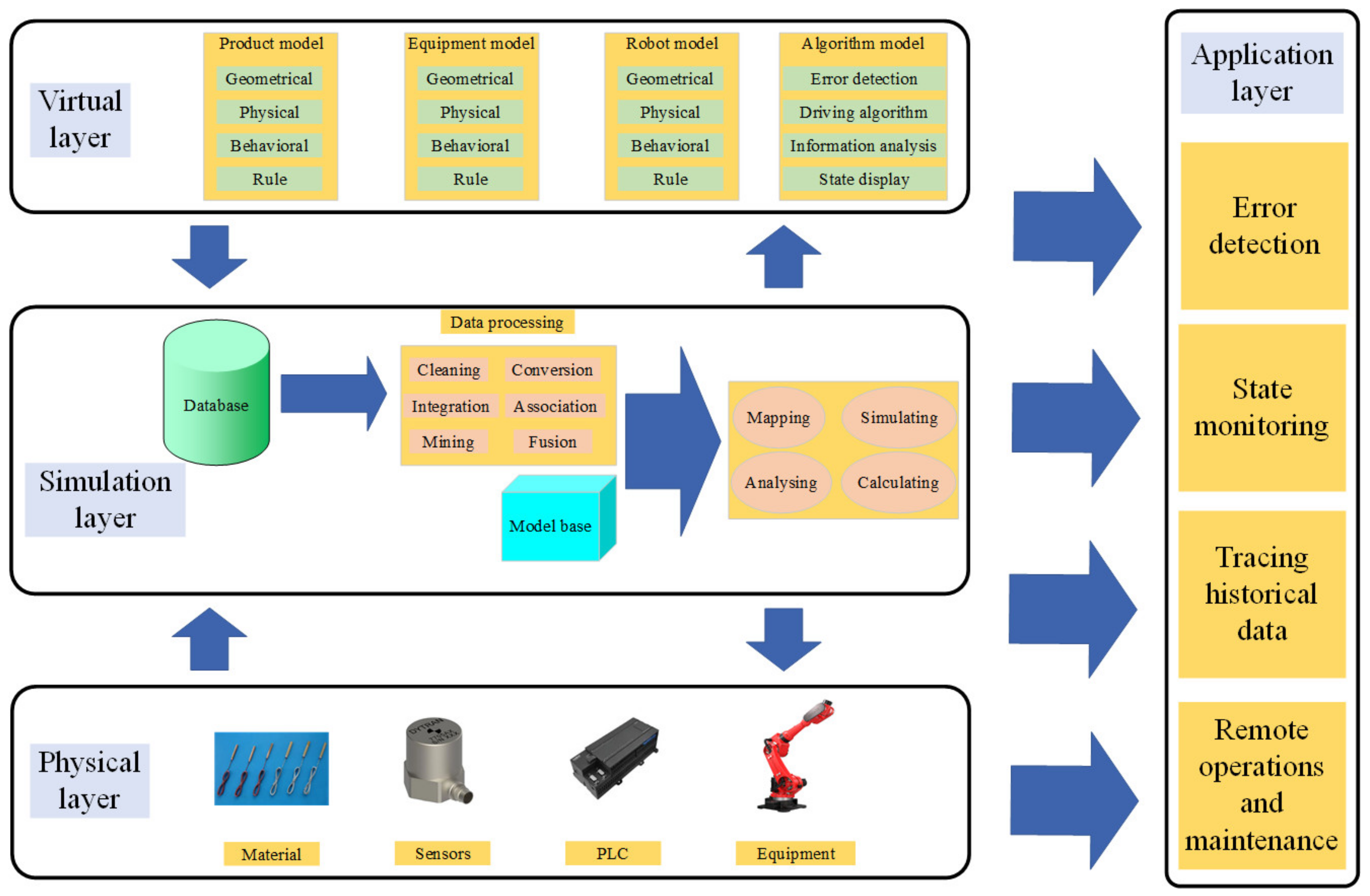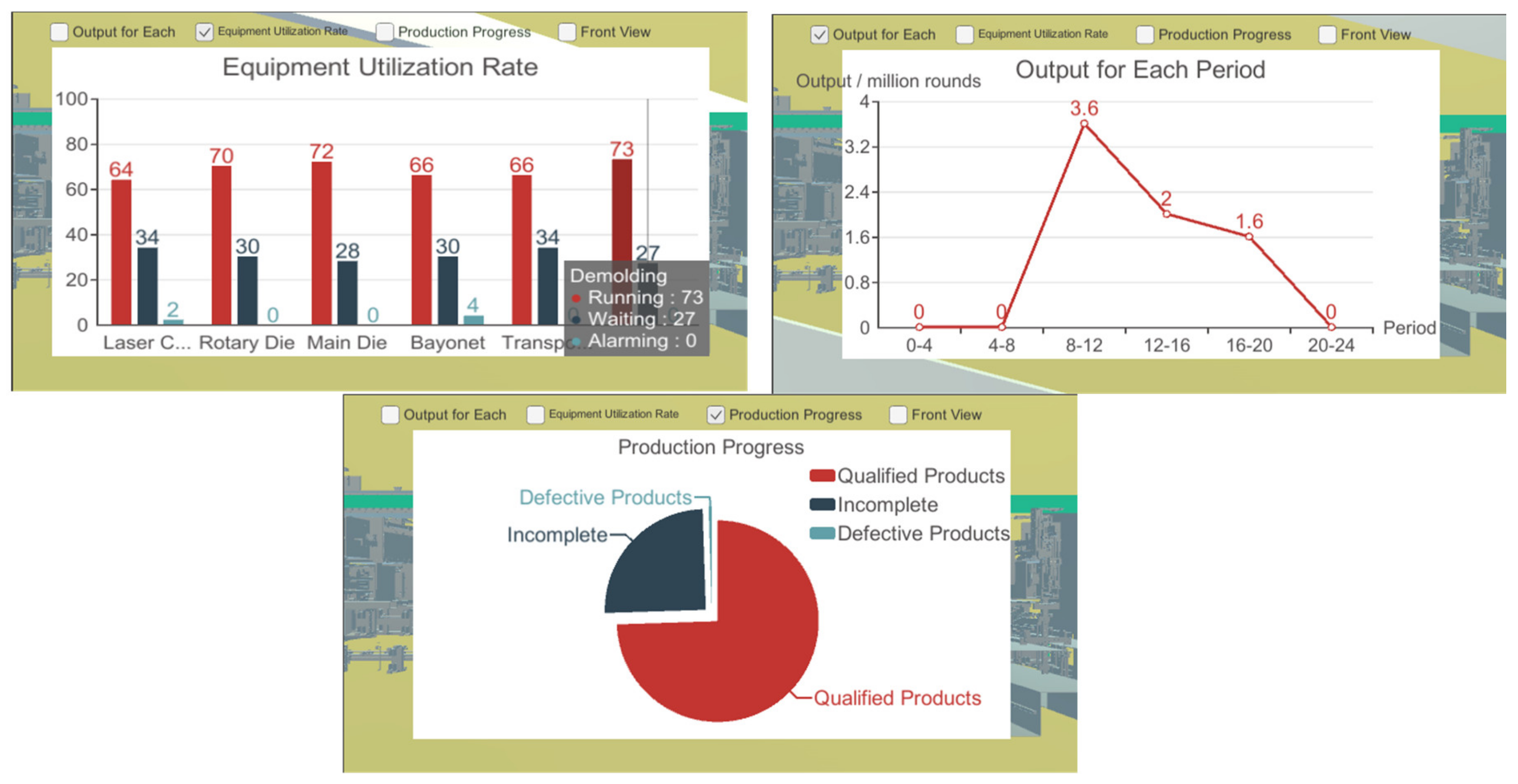Visualization Monitoring of Industrial Detonator Automatic Assembly Line Based on Digital Twin
Abstract
1. Introduction
- ➀
- The monitoring results are mostly presented in traditional numerical charts, which cannot directly describe the real-time status of the object, and it is difficult to give managers a reference for decision-making.
- ➁
- The lack of research on the visual monitoring methods of the production process in special fields such as the chemical industry, blasting and nuclear energy.
- ➂
- Most of the existing systems lack application services for the trajectory error detection of complex equipment on production lines, so the visual monitoring of the production process is not contributing enough.
2. Assembly Line Visualization Monitoring System Based on Digital Twin
- (1)
- Physical layer
- (2)
- Virtual layer
- (3)
- Simulation layer
- (4)
- Application layer
3. Key Implementation Methods
3.1. Assembly Line Virtual Entity Model Construction
3.2. Data Collection in Assembly Process
3.3. Complex Equipment Error Detection
- ➀
- Receive real-time data from the database and classify it into desired data and actual data .
- ➁
- Calculate the numerical error between and at the current moment according to Equation (9).
- ➂
- Plot the desired curve and the actual curve, and calculate the directional error between the two curves at the current moment according to Equation (10).
- ➃
- Calculate the error coefficient at the current moment according to Equation (8).
- ➄
- Visualize , and at the current moment to the users in real time.
- ➅
- Repeat the above steps until the error detection service is closed.
4. Case Study
4.1. Case Description
4.2. Implementation
4.3. Results and Discussion
5. Conclusions
Author Contributions
Funding
Institutional Review Board Statement
Informed Consent Statement
Data Availability Statement
Conflicts of Interest
References
- Sun, F.; Xu, H.; Zhao, Y.H.; Zhang, Y.D. Data-driven fault diagnosis of control valve with missing data based on modeling and deep residual shrinkage network. J. Zhejiang Univ. Sci. A 2022, 23, 303–313. [Google Scholar] [CrossRef]
- Wu, H.M.; Zhang, G.Y.; Guan, Y.S.; Juan, R. Multimodal time series modeling-based robot safety surveillance. J. Harbin Inst. Technol. 2020, 52, 126–132. [Google Scholar]
- Liu, J.K.; Hao, S.H.; Wang, S.H.; Fu, H.Y. Data driven technical framework of real-time monitoring and control optimization for CNC machining production line. J. Comput. Integr. Manuf. Syst. 2019, 25, 1875–1884. [Google Scholar]
- Wei, D.H.; Wang, H.F.; Liu, L.Y. Visual monitoring system for small and medium-sized automatic production lines. J. China Mech. Eng. 2020, 31, 1351–1359. [Google Scholar]
- Chen, X.L.; Wang, R.X.; Wang, J.; Zhou, J.L. Industrial process monitoring and fault diagnosis based on hybrid discriminant analysis. J. Acta Autom. Sin. 2020, 46, 1600–1614. [Google Scholar]
- Leng, X.W.; Chen, G.P.; Jiang, Y.; Zhang, J.Q.; Cao, Y.F. Data specification and processing in Big-data analysis system for monitoring and operation of smart grid. J. Autom. Electr. Power Syst. 2018, 42, 169–176. [Google Scholar]
- Ye, J.H.; Liu, S.L.; Liu, J.H.; Weng, G. On-site monitoring technology of complex product assembly workshop based on process. J. Comput. Integr. Manuf. Syst. 2017, 23, 1469–1480. [Google Scholar]
- Chen, P.; Liu, F.; Ning, J.F. Integrated model for multi-objective monitoring on automatic machining line and its application. J. Comput. Integr. Manuf. Syst. 2017, 23, 473–481. [Google Scholar]
- Rosen, R.; Von Wichert, G.; Lo, G.; Bettenhausen, K.D. About the importance of autonomy and digital twins for the future of manufacturing. J. IFAPapers Line 2015, 48, 567–572. [Google Scholar] [CrossRef]
- Grieves, M. Digital Twin: Manufacturing Excellence through Virtual Factory Replication; Florida Institute of Technology: Melbourne, FL, USA, 2014. [Google Scholar]
- Tao, F.; Zhang, M.; Cheng, J.F.; Qi, Q.L. Digital twin workshop: A new paradigm for future workshop. J. Comput. Integr. Manuf. Syst. 2019, 25, 2405–2418. [Google Scholar]
- Tao, F.; Ma, X.; Hu, T.L.; Huang, Z.G.; Cheng, J.F.; Qi, Q.L.; Zhang, M.; Liu, W.R.; Zhang, H.; Wang, S.G.; et al. Research on digital twin standard system. J. Comput. Integr. Manuf. Syst. 2019, 25, 2405–2418. [Google Scholar]
- Tao, F.; Qi, Q. Make more digital twins. J. Nat. 2019, 573, 490–491. [Google Scholar] [CrossRef] [PubMed]
- Zhao, H.R.; Liu, J.H.; Xiong, H.; Zhuang, C.B.; Miao, T.; Liu, J.S.; Wang, B. 3D visualization real-time monitoring method for digital twin workshop. J. Comput. Integr. Manuf. Syst. 2019, 25, 1432–1443. [Google Scholar]
- Zhang, Q.L.; Yang, Z.W.; Duan, J.G.; Liu, Z.; Qin, J.Y. Three-dimensional visualization interactive system for digital twin workshop. J. Southeast Univ. 2021, 37, 137–152. [Google Scholar]
- Liu, L.Y.; Du, H.X.; Wang, H.F.; Liu, T.Y. Construction and application of digital twin system for production process in workshop. J. Comput. Integr. Manuf. Syst. 2019, 25, 1536–1545. [Google Scholar]
- Ma, J.; Wang, Y.C.; Zhao, M.; Jiang, Z.Q.; E, M.C.; Wang, Q. Visualization management and control methods of production cell based on digital twin. J. Comput. Integr. Manuf. Syst. 2021, 27, 1256–1268. [Google Scholar]
- Wu, P.X.; Guo, Y.; Huang, S.H.; Yang, N.J.; Xiong, W.J.; Guo, J.T. Visual real-time monitoring method for distance manufacturing workshop based on digital twin. J. Comput. Integr. Manuf. Syst. 2021, 27, 1605–1616. [Google Scholar]
- Wei, Y.X.; Guo, L.; Chen, L.X.; Zhang, H.Q.; Hu, X.T.; Zhou, H.Q.; Li, G. Research and implementation of digital twin workshop based on real-time data driven. J. Comput. Integr. Manuf. Syst. 2021, 27, 352–363. [Google Scholar]
- Zhou, C.; Sun, K.T.; Li, J.; Yu, C.G.; Ju, L.K. Workshop 3D visual monitoring system based on digital twin. J. Comput. Integr. Manuf. Syst. 2022, 28, 758–768. [Google Scholar]
- Tao, F.; Zhang, C.Y.; Qi, Q.L.; Zhang, H. Digital twin maturity model. J. Comput. Integr. Manuf. Syst. 2022, 28, 1267–1281. [Google Scholar]
- Tao, F.; Liu, W.R.; Zhang, M.; Hu, T.L.; Qi, Q.L.; Zhang, H.; Sui, F.Y.; Wang, T.; Xu, H.; Huang, Z.G.; et al. Five-dimension digital twin model and its ten applications. J. Comput. Integr. Manuf. Syst. 2019, 25, 1–18. [Google Scholar]
- Tao, F.; Zhang, H.; Qi, Q.L.; Xu, J.; Sun, Z.; Hu, T.L.; Liu, X.J.; Liu, T.Y.; Guan, J.T.; Chen, C.Y. Theory of digital twin modeling and its application. J. Comput. Integr. Manuf. Syst. 2021, 27, 1–15. [Google Scholar]
- Zhang, C.Y. Research on Reconfigurable Modeling of Industrial Robotic Digital Twin Manufacturing Systems. Master’s Thesis, Wuhan University of Technology, Wuhan, China, 2020. [Google Scholar]
- Li, L.B. Development of Production Measurement Process Monitoring System Based on Digital Twin. Master’s Thesis, Donghua University, Shanghai, China, 2022. [Google Scholar]
- Dai, S.; Zhao, G.; Yu, Y.; Zheng, P.; Bao, Q.W.; Wang, W. Ontology-based information modeling method for digital twin creation of as-fabricated machining parts. J. Robot. Comput.-Integr. Manuf. 2021, 72, 102173. [Google Scholar] [CrossRef]
- Liu, H.L.; Yue, P.; Xia, C.H.; Zhao, W.J. Discrete manufacturing workshop virtual entity behavioral model description method based on VDEVS. J. Comput. Integr. Manuf. Syst. 2021, 27, 2950–2960. [Google Scholar]
- Chou, X.L.; Zhu, R.; Xing, Y.; Hu, J.Y. Digital twin modeling technology for solenoid assembly production line. J. Comput. Integr. Manuf. Syst. 2022, 28, 1696–1703. [Google Scholar]
- Fan, J.W.; Yang, Y.; Pan, R.; Li, W.H. Development of remote monitoring system for CNC machine tools based on OPC UA. J. Mach. Tool Hydraul. 2022, 50, 44–48+54. [Google Scholar]
- Sun, Y.L.; Ma, W.M.; Zhang, C.; Song, Y.J.; Cui, J. Research on key technologies of digital twin-oriented intelligent production line monitoring system. J. Aeronaut. Manuf. Technol. 2021, 64, 58–65. [Google Scholar]
- Qiao, F.; Guan, L.E.; Wang, Q.L. A fast similarity calculation method based on cotangent similarity and BP neural network. J. Tongji Univ. (Nat. Sci.) 2021, 49, 153–162. [Google Scholar]












Disclaimer/Publisher’s Note: The statements, opinions and data contained in all publications are solely those of the individual author(s) and contributor(s) and not of MDPI and/or the editor(s). MDPI and/or the editor(s) disclaim responsibility for any injury to people or property resulting from any ideas, methods, instructions or products referred to in the content. |
© 2023 by the authors. Licensee MDPI, Basel, Switzerland. This article is an open access article distributed under the terms and conditions of the Creative Commons Attribution (CC BY) license (https://creativecommons.org/licenses/by/4.0/).
Share and Cite
Li, H.; Yang, Y.; Zhang, C.; Zhang, C.; Chen, W. Visualization Monitoring of Industrial Detonator Automatic Assembly Line Based on Digital Twin. Sustainability 2023, 15, 7690. https://doi.org/10.3390/su15097690
Li H, Yang Y, Zhang C, Zhang C, Chen W. Visualization Monitoring of Industrial Detonator Automatic Assembly Line Based on Digital Twin. Sustainability. 2023; 15(9):7690. https://doi.org/10.3390/su15097690
Chicago/Turabian StyleLi, Hongjun, Yu Yang, Chi Zhang, Chengjun Zhang, and Wei Chen. 2023. "Visualization Monitoring of Industrial Detonator Automatic Assembly Line Based on Digital Twin" Sustainability 15, no. 9: 7690. https://doi.org/10.3390/su15097690
APA StyleLi, H., Yang, Y., Zhang, C., Zhang, C., & Chen, W. (2023). Visualization Monitoring of Industrial Detonator Automatic Assembly Line Based on Digital Twin. Sustainability, 15(9), 7690. https://doi.org/10.3390/su15097690









